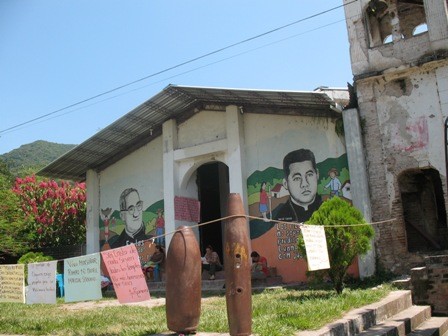Community Development Projects, News from Communities, Sister Cities
Cinquera Struggles to Preserve Community’s Church Under Attack
From ContraPunto, translated by Sister Cities
A community struggles to maintain its historical walls that are not just simple adobe structure. These walls show their own history and the history of the country. The parish wanted to knock down these walls, but the people said no.
Siting on a plastic chair, Elba Escalante, 68 years old, stands guard at the entrance to the church in Cinquera, Cabanas, a town that during the war, disapeared from the map because of the devestating force of arial bombing, but later resurged like a Phoenix. Behind her, Archbishop Oscar Arnulfo Romero, asasinated by death squads in 1980, observes all from the mural painted in his honor on the side of the temple.
Elba and the rest of her companeros from the “Christian Community Cristiana Aida Escalante” have peacefully taken over this temple. There is a plastic cord around the outside of the church to prevent access to the building, and from that cord hang posters with messages about the temple and quotes from Archbishop Romero: “Without Christ, temples have no use, no matter how beautiful they are “.
The members of this religious community fear that the priest who serves the town, Emilio Rivas, will try to tear down the front and side walls of the temple, as he attempted, unsuccessfully, on October 13th. He considers these structures to be useless, although for the population they have a great symbolic significance.
Cinquera, while under the control of the geurillas, was reduced to nothing during El Salvador’s civil war. 500-pound bombs rained down and destroyed the community completely; some unexploded bombs today stand guard in front of the church, as a silent witness to the war’s atrocities.
Only the bell tower of the church survived, punctured by shrapnel fire. Some sections of the front and north walls of the church also survived, and were later restored by the population.
The punctured bell tower and semi destroyed walls of the original church are the only buildings remaining of the era of the civil war in Cinquera. They serve as evidence of the military conflict that all of El Salvador experienced from 1980 and 1992, which according to estimates left some 70,000 people dead.
For the majority of the population, these walls should be preserved because they are part of the cultural and historical heritage of the people. The new generations should know this history, so that it will never happen.
But the priest believes that the walls are just something old that would be dangerous if they were to collapse.
That is how on October 13th at about 7:30 am, Father Rivas arrived with about 100 men armed with spades, sticks, hoes and shovels, with a firm determination to knock down those historic walls, the only traces of the days of war. For part of the community the walls are like a museum: they give a testimony to the present and future generations about how painful the war was.
But people were opposed, in the midst of commotion. Holding hands, they formed a human chain and prevented those adobe walls from falling down because of someone’s senselessness.
Since then, Elba and her friends arrive every day to guard the perimeter of the chruch. They are not going to let the priest attempt a new offensive of picks and hoes.
“It was so difficult for us to rebuild everything, and these walls are part of our history, and we will not allow anyone to come and destroy them,” says Elba, as she smokes a cigarette.
She was among the group of seven families who repopulated Cinquera in February of 1991, when the war had not yet ended.
“When we arrived, this was a ghost town; I could not even recognize my house, because there were no houses,” says Elba. “There were just snakes coiled in the trees”.
Her daughter, Aida Escalante- from whome comes the name of the Christian community- was a young catechist who was 17 when she was brutally murdered by the death squads in 1980.
Nothing that smells of Romero .
The priest’s desire to tear down the walls of the temple is not only because the walls are old, say residents of Cinquera, that’s just the justification.
The background is more shadowy: he is a conservative, right wing, who has insisted since coming to town in January of 2009, of wanting want to erase icons from the past civil war that still permeate all parts of the church: posters of Archbishop Romero and Rotilio Grande, another priest that was murdered, fotographs of combatants and civilians who were killed in the conflict in the Cinquera zone, photographs of the priests from the Central American University (UCA) who were massacred in 1989, and so on.
These images are an important reference for the majority of the population, who lived close to the town’s revolutionary past.
There is, therefore, a frontal collision between the conservative vision of the priest and the majority of the population, on the left, who are followers of liberation theology and of Archbishop Romero.
“Since the day he came he began to directly attack the community,” says Amilcar Lobo, a member of the Christian Community.
Lobo says says that the Father Rivas arrived prejudiced by the Parish, which began in 2007, also from a conservative perspective. “He said the church had to look pretty, indirectly saying that he did not like the focus that had given the community had given the church,” Wolf tells.
Things heated up further last Easter. Rivas covers Cinquera but does not live there, so he sent the Mexican-born Preist Clemente Velasquez, who villagers say showed an attitude that was even more aggressive than Rivas.
The Mexican priest changed the traditional Holy Week stations of the cross, which had been arranged by members of the Christian Community, giving them to members of the Charismatic Congregation in the town, who support the Priest because they too are right wing, said Marina Alvarenga.
“He said that we should not follow dead leaders, referring to Archbishop Romero,” she adds. “One day he told us to forget the past and the historic “garbage” that we follow. “He said that Romero was not a martyr, that the best we can do is pray that God forgives our sins because Romero died because he was political”.
On the Sunday following Holy Week, Father Rivas returned to Cinquera. He said during Mass that the church was private property, and that those who were creating disorder were going to be brought to the police, according to those who denounced it.
Counterpoint tried unsuccessfully to interview the Father Rivas over the phone.
“They are lazy”
All of this was heating up the atmosphere that led to what happened on Tuesday October 13th, when the priest arrived with a small army of workers who wanted to demolish the walls of the main and Northern walls of the church.
Rodolfo Sosa, the Mayor of Cinquera with the Alianza Republicana Nacionalista (Arena) party, also participated. He is an ally of Father Rivas, by political affinity, and actually accompanied the priest in an attempt to tear down the walls, as shown in a home video filmed during the activity.
Counterpoint saw Sosa across the park in front of the church, sitting in a double cab pickup. What were you doing there with the father on that day of craziness?, We ask.
“My role was to support, the father asked me to,” he says. “I did not bring these people with picks, that was the Father,” he adds.
The mayor adds: “They (the people from the Christian Community) are not truly faithful, they are some bums who take advantage of the temple in order to preach guerrilla doctrine against the ARENA party.
This party ruled El Salvador for 20 years with neoliberal policies that impoverished the population. But they lost the presidential election last March, and the former guerrillas of the FMLN are now the ruling party.
The mayor added that those who have taken over the temple are interested in maintaining the church “with things from the war” because they take advantage of it financially: the foreigners who come to the town bring them donations, etc.. “They are accustomed to reading messages and notes written by Archbishop Romero.” Says the former policeman turned mayor after winning the mayor’s office last January by 22 votes. “They are not Christians, they are from the FMLN party.
Is it true that you won the mayor’s position by 22 votes, from people that you brought in from elsewhere?, we asked him
“God knows that’s not true, I did not bring a single vote from another town,” he replies.
Reason Triumphs
The day that Father Rivas attempted to tear down the walls Rivas, he carried an official document under his arm which supported him. It was a report from the now defunct National Council for Arts and Culture (Concultura) from July 16th of this year, which approved the destruction of the structures identified.
The document was the result of a process that began with technical inspections by staff of Concultura, which were requested on June 22nd, 2009 by the Catholic Church, who own the church in Cinquera.
The document, in effect, endorsed the demolition of the adobe structures identified. It was based on an inspection by technicians: the walls had already been interlaced with materials that were incompatible with the original and, also posed a risk that they would collapse.
The report from Concultura came out in the moment of transition between the previous ARENA government and the new government of Mauricio Funes from FMLN, who took office on June 1st.
But now the new Department of Culture, a new entity that emerged from the ashes of Concultura, has taken up the case with a new approach. Breny Cuenca, the Minister of Culture, visited Cinquera on October 19th and agreed to a public review the decision.
“We did not know of the conflict with the parish. We cannot ignore this situation, the reasonable demand of the community, and we did not know enough about this when the decision was made,” said Sonia Baires, the new Director of Cultural Heritage.
“We will review the resolution so that it focuses on sustaining these structures,” he says.
“The walls have an intangible symbolic value that the community wants to preserve,” he adds.
Back in Cinquera, Elba weeps as she looks at the photo of her daughter on a mural made of newspapers located on one of the newer interior walls of the temple.
After having failed in all of his attempts to remove the symbols of the historical memory of the people, Father Rivas has said, according to community members, that he will never come back to give mass at Cinquera.
Elba can be relieved, for the moment.

